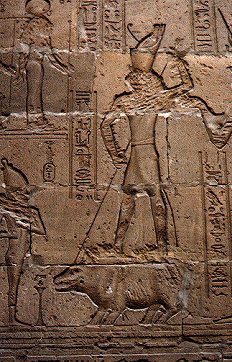
Ancient Egypt The Rosetta Stone and Hieroglyphics
In July of 1799 Napoleon's army was making fortification in northern Egypt after conquering the country. One of the French soldiers who was digging in the area near Rosetta hit upon a small black rock. The rock had carvings in three different styles of writing. After studying the stone, scholars realized that two of the styles of writing on the stone were ancient Egyptian. Both of the styles were so ancient that no one had been able to translate them. The third style was Greek. The Greek was easy to translate. When the scholars realized that the message was probably the same one written in three different ways, the ability to read Greek helped scholars understand many things about hieroglyphs.
Hieroglyphics was a form of picture writing with about 700 signs. In 1824 Jean Francois Champollion worked out how they should be read. Instead of letters the writing used signs. They were written in lines straight across or up and down without spaces or punctuation marks. Many hieroglyphs were a kind of picture of what they represented. For example a bird was represented with a picture of a bird, or a picture of a foot might have stood for the word walking. Later the pictures stood for sounds instead of whole words. After this Egyptians could spell out words like we do today. The Rosetta Stone can now be seen in the British Museum in London.
Scribes and Scholars
Not many people could read during the time of Ancient Egypt. The scribes had the ability. Scribes were sons of powerful people. They went to school to learn how to write. Scribes kept records of the royal family and high priest.
When scribes were working on documents such as letters, livestock registers, and ledgers they wrote very fast. They wrote on limestone fragments or pieces of broken pottery. They were written with ink using a reed. The scribes wrote reports and detailed accounts according to the king's orders.
Scribes wrote a variety of texts. They worked in the temples to re-copy religious text. They also wrote instructions to guide the dead in the afterlife. They wrote magical spells on amulets to protect the living from sickness. Scribes wrote stories, poems, and fables.
Early scribes developed a system for working with numbers. Scribes did not know how to divide so they divided numbers by a series of subtractions. They did not use a zero.
Scribes also drew the night sky. They drew maps locating the constellations of stars. They used these drawings to design a calendar. They invented a 365 day calendar. They divided it into twelve months with thirty days in each. They added five extra days at the end of the year.
Student Project
Have students print out their names or other meaningful text using the Hieroglyphics Generator. Then have students create duplicate the drawing in salt dough using a pencil.
See our projects here.